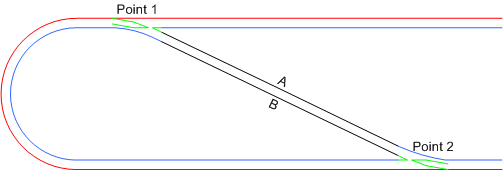Many railways have no need fo rthis. But sometimes a track section is laid which "goes back on itself". This leads to a train being able to run around a loop and back onto the original track, reversing its direction as it goes. The power into such a track section needs to be provided carefully: here's why.

Look at the track section drawn. The diagonal track from bottom right to top left is a reverse loop. Now look at how the rains need to be powered:
- If point 1 is set for a train to enter the loop, rail A must be connected to the "red" rail and rail B connected to the "blue" rail.
- If point 2 is set for a train to enter the loop, rail A must be connected to the "blue" rail and rail B connected to the "red" rail.
That means that a train can't run through that loop without something happening! The solution is for the track polarity to be changed using some kind of changeover switch. The track needs both rails at each end to be isolated, and for its power to be separately wired. When the train enters the loop, it has one polarity; when it exits, it has the other.
On a DC railway, the solution is simple. The train is halted, and the track polarity is then flipped with a switch. (That switch could be a relay which changes according to the position of a point). The train can then re-start on its journey. On a DCC railway, there is an extra option: an autoreverser can change the polarity automatically. This means the train need not stop.
An autoreverser is quite simple. it consists of a changeover switch (usually a relay, but it can be electronic) and a short circuit detector. When the short circuit detector identifies a short, the rail polarity is "flipped". When a train drives across th track breaks onto the central section, the polarity ill be either correct in inverted. If it is inverted, a short circuit occurs. The autoreverser detects that short, and "flips" the track polarity. This happens more quickly that the booster's short circuit protection, and everything continues normally. The train crossing the track gap will see one DCC packet corrupted, but it will always have power. The train's speed is unaffected and it decodes the next packets without a problem.
